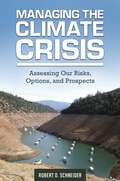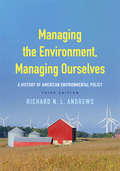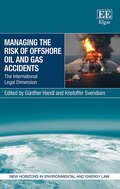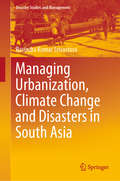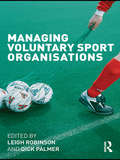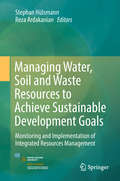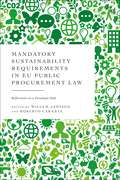- Table View
- List View
Managing Sport Business: An Introduction (Foundations of Sport Management)
by David HassanContemporary sport is both a sophisticated and complex international business and a mass participatory practice run largely by volunteers and community organisations. Now in a fully revised and expanded second edition, this authoritative and comprehensive introduction to the theory and practice of sports management helps to explain the modern commercial environment that shapes sport at all levels and gives clear and sensible guidance on best practice in sports management, from elite sport to the local level. The first section examines the global context for contemporary sports management. The second explores the key functional areas of management, from organisation and strategy to finance and marketing, and explains how successful managerial techniques can be applied in a sporting context. The final section surveys a wide range of important issues in contemporary sports management, from corporate social responsibility to the use of information and communication technologies. Together, these sections provide a complete package of theory, applied practical skills and a state-of-the-art review of modern sport business. Complemented by a companion website full of additional resources, this book is essential reading for all students of sport management and sport business.
Managing the Climate Crisis: Assessing Our Risks, Options, and Prospects
by Robert O. SchneiderUsing a risk management approach to tease apart the complex issue of climate change, this book assesses the key vulnerabilities and redirects the discussion to present a comprehensive plan to overhaul our response to climate change.According to the 2014 U.S. Climate Report, temperatures might increase by 5 degrees even with aggressive strategies to reduce greenhouse gas emissions and could increase by as much as 10 degrees if emissions continue unabated. The report also predicts increases in extreme weather caused by global warming will continue. It is time to apply the lessons of sustainable disaster mitigation and hazard resilience to respond to the challenges posed by global warming, identify and assess the options we have for addressing the crisis, and create a practical plan for managing the problem.Unlike other books on climate change, this one uniquely applies a risk management approach to answer the question, "Considering what our policies look like now, what do we need to do next to mitigate climate change?" Robert O. Schneider, PhD, explains how the warming climate will affect everything from peak temperatures and weather extremes to infrastructure such as groundwater reservoirs, airports, and wastewater systems, making the dire nature of the crisis clear to readers in practical and personal terms. By enabling readers to understand the scientific and historical contexts of the climate crisis, the author makes a compelling case for the urgency of implementing a national climate policy to respond to the challenges posed by global warming.
Managing the Climate Crisis: Assessing Our Risks, Options, and Prospects
by Robert O. SchneiderUsing a risk management approach to tease apart the complex issue of climate change, this book assesses the key vulnerabilities and redirects the discussion to present a comprehensive plan to overhaul our response to climate change.According to the 2014 U.S. Climate Report, temperatures might increase by 5 degrees even with aggressive strategies to reduce greenhouse gas emissions and could increase by as much as 10 degrees if emissions continue unabated. The report also predicts increases in extreme weather caused by global warming will continue. It is time to apply the lessons of sustainable disaster mitigation and hazard resilience to respond to the challenges posed by global warming, identify and assess the options we have for addressing the crisis, and create a practical plan for managing the problem.Unlike other books on climate change, this one uniquely applies a risk management approach to answer the question, "Considering what our policies look like now, what do we need to do next to mitigate climate change?" Robert O. Schneider, PhD, explains how the warming climate will affect everything from peak temperatures and weather extremes to infrastructure such as groundwater reservoirs, airports, and wastewater systems, making the dire nature of the crisis clear to readers in practical and personal terms. By enabling readers to understand the scientific and historical contexts of the climate crisis, the author makes a compelling case for the urgency of implementing a national climate policy to respond to the challenges posed by global warming.
Managing the Environment, Managing Ourselves: A History of American Environmental Policy
by Richard N. AndrewsIn the third edition of this definitive book, Richard N. L. Andrews looks back at four centuries of American environmental policy, showing how these policies affect contemporary environmental issues and public policy decisions, and identifying key policy challenges for the future. Andrews crafts a detailed and contextualized narrative of the historical development of American environmental policies and institutions. This volume presents an extensively revised text, with increased detail on the 50-year history of the modern environmental policy era and updated through the Obama and Trump administrations.
Managing the Future of Southeast Asia's Valuable Tropical Rainforests: A Practitioner's Guide to Forest Genetics (Advances in Asian Human-Environmental Research)
by Ratnam Wickneswari and Chuck CannonThis book provides current knowledge about tropical rain forest genetics and its implications for the profitable and sustainable management of forest resources in Southeast Asia. Each chapter covers a major topic in the evolutionary biology of tropical rain forest trees and how management systems interact with these natural dynamics. Authors provide an up-to-date and insightful review of important scientific findings and conclude with practical recommendations for the modern forester in Southeast Asia. Several chapters provide compelling discussions about commonly neglected aspects of tropical forestry, including the impact of historical dynamics of climate change, anthropogenic threats to genetic viability, and the important role of wildlife in maintaining genetic diversity. These discussions will promote a deeper appreciation of not only the economic value of forests, but also their mystery and intangible values. The silvicultural industry in Southeast Asia is a major contributor to the regional economy but the connection between scientific research and the application and development of policy could be improved upon. This book will help bridge that gap. This book will prove beneficial reading for forestry students, professional forest managers, and policy makers, who do not have technical training in genetics. It is also intended for non-specialists who are involved in the tropical timber industry, from the local forest manager to the international timber purchasing agent.
Managing the Risk of Offshore Oil and Gas Accidents: The International Legal Dimension (New Horizons in Environmental and Energy Law series)
by Günther Handl Kristoffer SvendsenThis book provides a comprehensive analysis of the international legal dimension of the management of the risk of accidents associated with offshore oil and gas activities. The editors cover the prevention and minimization of harm as well as the post-accident management of loss through liability and compensation arrangements and the processing of mass claims for compensation. While postulating a public international law framework for offshore oil and gas operations globally and exploring critical elements thereof, this book draws heavily on comparative assessments of domestic concepts and approaches, especially as regards offshore safety, liability for and compensation of harm, and mass tort claims procedures. With a team of experts from all over the world as contributing authors, the book offers a unique perspective on what remains a pressing international concern: The safety of offshore operations globally and the proper allocation of loss should a major accident occur. Government officials, international civil servants and academics in related fields will find the book a valuable resource.
Managing the Unknown: Essays on Environmental Ignorance (Environment in History: International Perspectives #3)
by Frank Uekötter and Uwe LübkenInformation is crucial when it comes to the management of resources. But what if knowledge is incomplete, or biased, or otherwise deficient? How did people define patterns of proper use in the absence of cognitive certainty? Discussing this challenge for a diverse set of resources from fish to rubber, these essays show that deficient knowledge is a far more pervasive challenge in resource history than conventional readings suggest. Furthermore, environmental ignorance does not inevitably shrink with the march of scientific progress: these essays suggest more of a dialectical relationship between knowledge and ignorance that has different shapes and trajectories. With its combination of empirical case studies and theoretical reflection, the essays make a significant contribution to the interdisciplinary debate on the production and resilience of ignorance. At the same time, this volume combines insights from different continents as well as the seas in between and thus sketches outlines of an emerging global resource history.
Managing the Wild: Stories of People and Plants and Tropical Forests
by Charles M. PetersDrawn from ecologist Charles M. Peters’s thirty†‘five years of fieldwork around the globe, these absorbing stories argue that the best solutions for sustainably managing tropical forests come from the people who live in them. As Peters says, “Local people know a lot about managing tropical forests, and they are much better at it than we are.” With the aim of showing policy makers, conservation advocates, and others the potential benefits of giving communities a more prominent conservation role, Peters offers readers fascinating backstories of positive forest interactions. He provides examples such as the Kenyah Dayak people of Indonesia, who manage subsistence orchards and are perhaps the world’s most gifted foresters, and communities in Mexico that sustainably harvest agave for mescal and demonstrate a near†‘heroic commitment to good practices. No forest is pristine, and Peters’s work shows that communities have been doing skillful, subtle forest management throughout the tropics for several hundred years.
Managing Urbanization, Climate Change and Disasters in South Asia (Disaster Studies and Management)
by Ravindra Kumar SrivastavaThis book offers essential insights into potential catastrophic events that might befall upon the emerging urban landscape in South Asia, and which are due to hazards, risks and vulnerabilities inherent in the region’s geophysical location, as well as due to climate change and unplanned urbanization. It highlights major physio-graphic, demographic, geological and geophysical indicators that are responsible for changing the pattern and trend of urbanization in South Asia – a crucial issue in view of emerging threats of climate change, and changes in the demographic profile. The book addresses the disaster management scenario in South Asia, manifestations of climate change in the region and various urban setups under climate-change-induced risks. Further, it elaborates on the challenges of urbanization-based neo-risks and vulnerabilities, which manifest in the form of slum area growth, piling and littering of waste and filth, new health risks, groundwater contamination, air pollution, highly energy-dependent lifestyles, poverty, socio-economic tensions, etc. It also critically examines the institutional mechanisms for disaster risk reduction (DRR), climate change adaptation (CCA) and urban governance, and suggests appropriate changes in the governing structure to mitigate these risks. The book draws the attention of urban planners and policymakers to current shortcomings in the administrative and financial structures of local urban bodies. While outlining climate-associated risks and adaptation strategies in South Asia, it also suggests measures for integrating climate change and urban adaption with state's planning processes, and puts forward a risk alleviation platform to bring the risk managers working in different fields together, so that they make concerted efforts to achieve sustainable development. It offers valuable takeaways for researchers, urban planners, those working in industry, consultants, and policymakers.
Managing Visitor Experiences in Nature-based Tourism
by Ali Thompson Mick Abbott Karl Agius Mary E. Allen George Ariya Rocío Blanco-Gregory Cameron Boyle Robert C. Burns Kadir Çakar Eugenio Conti Fernando Enseñat-Soberanis Sonia Ferrari Peter Fredman Azizul Hassan Stuart Hayes Nicolaia Iaffaldano Woody Lee Tiago Lopes Brent Lovelock Andrés Ried Luci Lusine Margaryan Johnathan Mondragón-Mejía Ana Goytia Prat Haywantee Ramkissoon Francisco Silva Jeffrey C. Skibins Ismail UzutThis book focuses on the experiences of tourists visiting nature-based destinations, exploring current knowledge and providing insights into conceptual issues through the use of empirical evidence from five continents. Presented as three topics, the contents discuss tourism and nature-based experiences by looking at the role and relevance of nature and the uniqueness of such experiences. The book identifies visitor management challenges and provides explanations for the solutions reached. The final section takes a more overarching destination management perspective that transcends the tourism product or business level and focuses on destination and generic issues like indicators or marketing implications. The book also includes research-based case studies which contribute to an overall understanding of the core issues involved in managing visitor experiences in nature-based tourism.
Managing Voluntary Sport Organizations
by Leigh RobinsonContemporary sport could not function without the involvement of voluntary organizations, from local grass-roots clubs to international agencies such as the International Olympic Committee. Management of this sector continues to undergo profound change, largely in response to the challenges of professionalization and increasing expectations in terms of transparency, accountability and ethical behaviour. This book fills a significant gap in the literature on sport management by setting out the principles and practices necessary for effective management of voluntary sport organizations around the world. In addition to applying and adapting established management strategies and techniques to voluntary sport organizations, this book is the first to fully relate mainstream organizational theory to this important sector of sport management. With contributions from an international team of researchers and management practitioners, the book explores key functional areas such as: governance strategy and planning human resources finance managing change marketing event management risk management. Each chapter discusses best practice and includes case study material, self test questions and guides to further reading. As the only book to outline a professional, theoretically informed and practically focused curriculum for voluntary sport management, this book is essential reading for all students of sport management and all managers working in or alongside the voluntary sector.
Managing Voluntary Sport Organizations
by Leigh Robinson Dick PalmerContemporary sport could not function without the involvement of voluntary organizations, from local grass-roots clubs to international agencies such as the International Olympic Committee. Management of this sector continues to undergo profound change, largely in response to the challenges of professionalization and increasing expectations in terms of transparency, accountability and ethical behaviour. This book fills a significant gap in the literature on sport management by setting out the principles and practices necessary for effective management of voluntary sport organizations around the world. In addition to applying and adapting established management strategies and techniques to voluntary sport organizations, this book is the first to fully relate mainstream organizational theory to this important sector of sport management. With contributions from an international team of researchers and management practitioners, the book explores key functional areas such as: governance strategy and planning human resources finance managing change marketing event management risk management. Each chapter discusses best practice and includes case study material, self test questions and guides to further reading. As the only book to outline a professional, theoretically informed and practically focused curriculum for voluntary sport management, this book is essential reading for all students of sport management and all managers working in or alongside the voluntary sector.
Managing Water Resources under Climate Uncertainty: Examples from Asia, Europe, Latin America, and Australia (Springer Water)
by Sangam Shrestha Anil K. Anal P. Abdul Salam Michael van der ValkThis book aims to come up with views to address the queries of planners, policymakers, and general people for water resources management under uncertainty of climate change, including examples from Asia and Europe with successful adaptive measures to change the challenge of climate change into opportunities. The availability of clean water is a major global challenge for the future due to a rapidly growing population and urbanization where further stress in water resources is expected due to the impact of climate change. The wide range of impacts includes for example changes in hydrology, moisture availability, spatial and temporal variations in magnitude of stream flow, and dwindling of water levels with adverse effect on wetlands and ecosystem. As a consequence, water management has become a serious issue and was identified as a global societal challenge, and climate change forecasting has become one of the key issues in recent research on sustainable water resources management.
Managing Water, Soil and Waste Resources to Achieve Sustainable Development Goals: Monitoring and Implementation of Integrated Resources Management (SpringerBriefs in Environmental Science)
by Stephan Hülsmann Reza ArdakanianThis book explores how integrated management of environmental resources via a Nexus Approach can help to achieve Sustainable Development Goals (SDGs). It takes a process-oriented view on what should or needs to be done to implement a Nexus Approach and how this relates to SDGs. After sketching the background and conceptual outline, contributions to the book explore key aspects of monitoring and implementation. Specifically, they: focus on the importance of monitoring resource use and how to advance it at the international level to support SDG implementation, exemplify the resources perspective on the nexus approach by exploring how to close the nitrogen cycle and stay within planetary boundaries, elaborate on proven and emerging strategies for nexus implementation, highlighting means to enhance, monitor and analyse stakeholder participation, explain how the horizontal and vertical nexus dimensions interact and can support SDG implementation. The book sheds new light on key aspects of the interrelation between SDGs and the Nexus Approach and provides specific recommendations how to advance it.
Managing Weather and Climate Risks in Agriculture
by Mannava Vk Sivakumar Raymond P. MothaBased on an International Workshop held in New Delhi, India, this work should be of interest to all organizations and agencies interested in improved risk management in agriculture. In many parts of the world, weather and climate are one of the biggest production risks and uncertainty factors impacting on agricultural systems performance and management. Both structural and non-structural measures can be used to reduce the impacts of the variability (including extremes) of climate resources on crop production.
Managing without Growth, Second Edition: Slower by Design, not Disaster
by Peter A. VictorTen years after the publication of the first edition of this influential book, the evidence is even stronger that human economies are overwhelming the regenerative capacity of the planet. This book explains why long-term economic growth is infeasible, and why, especially in advanced economies, it is also undesirable. Simulations based on real data show that managing without growth is a better alternative. The book tells how the recent idea of economic growth emerged from the idea of progress, itself only a few hundred years old. Many reasons for questioning growth are given based on an extensive review of the data as well as on conceptual and methodological considerations. The experience of growth in several countries is documented, compared and found wanting. Possibilities for managing without growth in high income economies are simulated with a new, comprehensive systems model with many novel features. Three 50 year scenarios are compared: a base case, an ambitious greenhouse gas reduction scenario, and a sustainable prosperity scenario with broader environmental objectives, reduced income inequality, shorter working hours and the cessation of economic growth. The book closes with a review of policies to make this scenario a reality. This updated book is a valuable resource for a broad academic audience, including students and researchers in economics, environmental studies, environmental science, business studies, and geography, as well as social justice groups and NGOs concerned with the environment, inequality and employment.
Mandatory Sustainability Requirements in EU Public Procurement Law: Reflections on a Paradigm Shift
by Willem Janssen and Roberto CarantaThis book provides the first comprehensive appraisal of the paradigm shift towards mandatory sustainability requirements in EU public procurement law.Traditionally, EU public procurement law focused on 'how to buy', dictating procedural rules so that public buyers in the Member States did not discriminate against suppliers and service providers from other Member States. Mandatory green and social requirements mean that, with a view to achieving sustainable development goals and mitigating climate change, the EU will limit this discretionary power for public buyers, pushing them to acquire more sustainable goods and services.Based on legal analysis informed by economic perspectives, the book aims to contribute to an understanding and critical discussion of the EU legislator's move towards regulating 'what to buy'. The book discusses the role of the Public Procurement Directives in relation to this paradigm shift, as well as various other sectoral legislative instruments that have been revamped or newly introduced in light of the European Green Deal.The paradigm shift is analysed from different perspectives, including subsidiarity, alternative regulation, economics and public purchasing. The book includes novel sectoral studies on transport, food, clothing, and construction, discussing how change is taking place and what its major challenges are for the future. Chapters on Italy, the Netherlands, Spain, and more, offer case studies of Member States that have already introduced mandatory requirements and highlight lessons learnt.This is an essential book for professionals working with public procurement law in academia and practice, and to those engaged in achieving public policy objectives in light of climate change and social injustice.
Mandatory Sustainability Requirements in EU Public Procurement Law: Reflections on a Paradigm Shift
This book provides the first comprehensive appraisal of the paradigm shift towards mandatory sustainability requirements in EU public procurement law.Traditionally, EU public procurement law focused on 'how to buy', dictating procedural rules so that public buyers in the Member States did not discriminate against suppliers and service providers from other Member States. Mandatory green and social requirements mean that, with a view to achieving sustainable development goals and mitigating climate change, the EU will limit this discretionary power for public buyers, pushing them to acquire more sustainable goods and services.Based on legal analysis informed by economic perspectives, the book aims to contribute to an understanding and critical discussion of the EU legislator's move towards regulating 'what to buy'. The book discusses the role of the Public Procurement Directives in relation to this paradigm shift, as well as various other sectoral legislative instruments that have been revamped or newly introduced in light of the European Green Deal.The paradigm shift is analysed from different perspectives, including subsidiarity, alternative regulation, economics and public purchasing. The book includes novel sectoral studies on transport, food, clothing, and construction, discussing how change is taking place and what its major challenges are for the future. Chapters on Italy, the Netherlands, Spain, and more, offer case studies of Member States that have already introduced mandatory requirements and highlight lessons learnt.This is an essential book for professionals working with public procurement law in academia and practice, and to those engaged in achieving public policy objectives in light of climate change and social injustice.
Manganese in Soils and Plants: Proceedings of the International Symposium on ‘Manganese in Soils and Plants’ held at the Waite Agricultural Research Institute, The University of Adelaide, Glen Osmond, South Australia, August 22–26, 1988 as an Australian Bicentennial Event (Developments in Plant and Soil Sciences #33)
by R. D. Graham R. J. Hannam N. C. UrenSixty years ago at the Waite Agricultural Research Institute, G. Samuel, a plant pathologist, and C. S. Piper, a chemist, published their conclusion that the cause of roadside take-all, a disease of oats, was manganese deficiency. This report, together with the concurrent and independent studies of W. M. Carne in Western Australia were the first records of manganese deficiency in Australia and came only six years after McHargue's paper which is generally accepted as the final proof of the essentiality of this element. There must have been a few doubts for some people at the time, however, as the CAB publication, 'The Minor Elements of the Soil' (1940) expressed the view that further evidence to this effect was provided by Samuel and Piper. Their historic contributions are recognised by the International Symposium on Manganese in Soils and Plants as it meets on the site of their early labours to celebrate the 60th anniversary. This year Australians also acknowledge 200 years of European settlement in this country and so the Symposium is both a Bicentennial and a diamond jubilee event which recognises the impact of trace elements on agricultural development in Australia. In a broader sense, a symposium such as this celebrates, as it reviews, the efforts of all who over the ages have contributed to our knowledge of manganese in soils and plants.
Mangrove Dynamics and Management in North Brazil (Ecological Studies #211)
by Ulrich Saint-Paul Horacio SchneiderMangrove ecosystems are being increasingly threatened by human activities. Their biotic productivity supplies food and other resources to the human populations that inhabit or make use of them. This volume highlights the results of a ten-year German / Brazilian research project, called MADAM, in one of the largest continuous mangrove areas of the world, located in northern Brazil. Based on the analysis of the ecosystem dynamics, management strategies for the conservation and sustainable use of mangroves are presented and discussed. Beyond the scientific results, this book also provides guidelines for the development of international cooperation projects.
Mangrove Ecosystems: Function and Management (Environmental Science and Engineering)
by Volker LinneweberProtection of the environment has nowadays become a major challenge and a condi tion for survival of future human generations and life on Earth in general. Yet it is still far too much of a dream or hope rather than a reality in the policy of our societies. Presently we are experiencing an unprecedented exponential growth of demography combined with a race for profit, resulting in excessive consumption particularly of en ergy, and a serious impact on the world ecosystems. Various types of pollutants and emerging new diseases not only disrupt the normal course of life, but also above this some of the atmospheric pollutants are most likely involved in the changing climate. We fear and literally shiver at the thought that the "changing climate" would ultimately disrupt the fragile thermodynamic equilibrium between the atmosphere and the oceans. Are we insensitive to these facts to the point of pushing our descendants, some genera tions ahead, into a new glacial period after a first period of warming up, at least, in northern Europe, like the one that took place 13 to 14 millennia ago? Surely the planet's nature is not prepared to be dominated by man and will go its way, whether humanity will be alive or dead.
Mangrove Ecosystems: Structure, Function, and Services
by Victor H. Rivera-Monroy Shing Yip Lee Erik Kristensen Robert R. TwilleyThis book presents a comprehensive overview and analysis of mangrove ecological processes, structure, and function at the local, biogeographic, and global scales and how these properties interact to provide key ecosystem services to society. The analysis is based on an international collaborative effort that focuses on regions and countries holding the largest mangrove resources and encompasses the major biogeographic and socio-economic settings of mangrove distribution. Given the economic and ecological importance of mangrove wetlands at the global scale, the chapters aim to integrate ecological and socio-economic perspectives on mangrove function and management using a system-level hierarchical analysis framework. The book explores the nexus between mangrove ecology and the capacity for ecosystem services, with an emphasis on thresholds, multiple stressors, and local conditions that determine this capacity. The interdisciplinary approach and illustrative study cases included in the book will provide valuable resources in data, information, and knowledge about the current status of one of the most productive coastal ecosystem in the world.
Mangrove Forests in India: Exploring Ecosystem Services
by Abhijit MitraThis is the first comprehensive science-based primer to highlight the unique ecosystem services provided by mangrove forests, and discuss how these services preserve the livelihoods of coastal populations. The book presents three decades of real-time data on Sundarbans and Bhitarkanika mangroves in India measuring carbon and nitrogen sequestration, as well as case studies that demonstrate the utility provided by mangroves for reducing the impact of storms and erosion, providing nutrient retention for complex habitats, and housing a vast reservoir of plant, animal and microbial biodiversity. Also addressed is the function of mangroves as natural ecosystems of cultural convergence, offering the resources and products necessary for thriving coastal communities. The book will be of interest to students, academics and researchers in the fields of oceanography, marine biology, botany, climate science, ecology and environmental geography, as well as consultants and policy makers working in coastal zone management and coastal biodiversity conservation.
Mangroves for Building Resilience to Climate Change
by R.N. Mandal R. BarThis valuable book is a comprehensive volume on mangroves, with information accessible to both botany professionals and students. It provides an easy method of identifying mangroves and distinguishing one species from another. What is a mangrove and what are the criteria of mangroves are explained, along with descriptions of distinctions among major mangroves, mangrove associates, mangrove halophytes, and back mangals. Many photos and illustrations are provided, showing the visible features of mangroves. The volume also covers a range of other topics, including habitats and climatic conditions, morphological and reproductive features, how climate change is affecting mangroves and methods of mitigation and conservation. This book is about mangroves, the intertidal coastal forests that struggle every moment against hungry tides because mangroves flourish at the interface zone of land and sea. Like an evergreen forest in the tropical and subtropical regions of the world, mangroves form definite coastal vegetation, providing protection to people living in such fragile zones against the occurrence of frequent natural calamities. Key features: Introduces important facts about mangroves: definition, early records of mangroves, categorization, and more Looks at the distribution of mangroves worldwide along with features of mangrove habitats and climatic conditions Describes the ecology and environmental conditions, particularly the concept of intertidal zones along estuary positions where tidal flows inundate mangroves Discusses the distinct morphological attributes and reproductive phenology of major mangroves Details the attributes of mangroves, covering a total of 78 species of intertidal flora, including 32 true mangroves, along with their diagnostic features, salient attributes, and illustrations for easy identification Highlights the burning environmental issue of climate change and its impact on mangroves Provides a variety of methods of restoration, conservation, and protection of mangroves
Mangroves for Building Resilience to Climate Change
by R.N. Mandal R. BarThis valuable book is a comprehensive volume on mangroves, with information accessible to both botany professionals and students. It provides an easy method of identifying mangroves and distinguishing one species from another. What is a mangrove and what are the criteria of mangroves are explained, along with descriptions of distinctions among major mangroves, mangrove associates, mangrove halophytes, and back mangals. Many photos and illustrations are provided, showing the visible features of mangroves. The volume also covers a range of other topics, including habitats and climatic conditions, morphological and reproductive features, how climate change is affecting mangroves and methods of mitigation and conservation. This book is about mangroves, the intertidal coastal forests that struggle every moment against hungry tides because mangroves flourish at the interface zone of land and sea. Like an evergreen forest in the tropical and subtropical regions of the world, mangroves form definite coastal vegetation, providing protection to people living in such fragile zones against the occurrence of frequent natural calamities. Key features: Introduces important facts about mangroves: definition, early records of mangroves, categorization, and more Looks at the distribution of mangroves worldwide along with features of mangrove habitats and climatic conditions Describes the ecology and environmental conditions, particularly the concept of intertidal zones along estuary positions where tidal flows inundate mangroves Discusses the distinct morphological attributes and reproductive phenology of major mangroves Details the attributes of mangroves, covering a total of 78 species of intertidal flora, including 32 true mangroves, along with their diagnostic features, salient attributes, and illustrations for easy identification Highlights the burning environmental issue of climate change and its impact on mangroves Provides a variety of methods of restoration, conservation, and protection of mangroves

